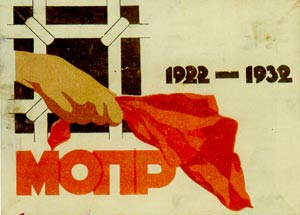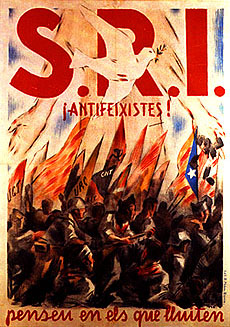International Red Aid facts for kids

Logo of the International Organisation for Assistance to Fighters for Revolution (MOPR), the Soviet section of the International Red Aid
|
|

MOPR poster from 1932
|
|
| Founded | 1922 |
|---|---|
| Founder | Communist International |
| Dissolved | 1941 (Soviet affiliate – 1947) |
| Focus | "Assistance in the creation of organizations to render material and moral aid to all captives of capitalism in prison." |
|
Area served
|
Worldwide |
|
Key people
|
Julian Marchlewski Clara Zetkin Elena Stasova |
The International Red Aid (also known as MOPR) was a worldwide organization. It was started in 1922 by the Communist International. Its main goal was to act like a "political Red Cross" for people around the world. MOPR helped those who were put in prison because of their political beliefs. They offered both practical help and moral support to these "class-war" prisoners.
Contents
What Was the International Red Aid?
How the Organization Started
The International Red Aid, or MOPR, was created in 1922. This happened after the 4th World Congress of the Comintern asked all communist parties to help. They wanted groups to form that would give support to people jailed under capitalism.
Julian Marchlewski-Karski was chosen to lead the main committee of MOPR. This committee was later called the Executive Committee after 1924.
The first big meeting of MOPR's leaders took place in Moscow in June 1923. At this meeting, they decided that MOPR should create branches in many countries. They especially wanted to help countries where revolutionary movements faced harsh treatment.
How MOPR Grew
The first international meeting for MOPR happened in July 1924. It took place at the same time as the 5th World Congress of the Comintern.
By January 1, 1928, MOPR had about 8.9 million members. These members were part of 44 national groups. This information came from Elena Stasova, who led the Russian part of MOPR. She was also a deputy leader for the international organization.
By January 1, 1931, MOPR had grown even more. It had 58 national groups with over 8.3 million members. At that time, the organization also published 56 newspapers and magazines in 19 different languages.
Stasova explained that MOPR worked in two ways. Some groups were "mass organizations" with many members, like those in the USSR, Germany, France, and the United States. Other groups were "committee type" organizations. These groups mainly focused on legal and financial help for political prisoners and their families. They did not try to get a lot of members.
Stasova also pointed out the difference between MOPR and Workers International Relief. Workers International Relief helped during economic strikes. MOPR, however, focused on helping political prisoners.
The first big MOPR World Congress was held in November 1932. It was announced that MOPR had 67 national groups outside the USSR. These groups had over 1.2 million members by January 1, 1932.
When MOPR Ended
Elena Stasova led MOPR until 1937. After this time, the organization became less focused on its international work. The main international group was dissolved in 1941. Its Soviet branch continued until 1947.
MOPR in Different Countries
By 1924, MOPR had groups in 19 countries. By 1932, it claimed to have 62 groups outside the Soviet Union. These groups had a total of 1,278,274 members.
Spain
The International Red Aid first appeared in Spain in October 1934. It acted as a charity during a workers' revolt in Asturias. MOPR helped those who were jailed for their part in the rebellion. They also worked to free prisoners who were going to be executed.
The organization included many artists and writers. It was later restarted and grew in Barcelona in January 1936. Its new goal was to fight against fascism in many ways.
MOPR's Work During the Spanish Civil War

During the Spanish Civil War, the writer Joaquín Arderíus was the president of the organization. He later moved to France and then Mexico. The SRI set up soup kitchens and refugee camps in areas controlled by the Republicans. They also provided libraries for Republican soldiers. Many of their programs and the aid they collected focused on helping children. For example, the SRI started the Escuela Nacional para Niños Anormales (National School for Mentally Disabled Children) in Madrid. It had 150 students. They also created a Children's Park outside Madrid, which sheltered another 150 children.
Other activities included:
- Building ways to transport people and supplies between hospitals and the front lines.
- Turning buildings like convents, churches, and palaces into temporary hospitals, clinics, blood banks, orphanages, and schools.
Their medical help included setting up 275 hospitals and ambulance services. They also created an Orthodontics Clinic and College. They ran campaigns for dental hygiene and sent dentists to the front lines. Another group, the Workers' Party of Marxist Unification (POUM), had its own similar group called Socorro Rojo del P.O.U.M..
MOPR's Military Support
Members of the SRI also joined the Fifth Regiment. This regiment was started by the Communist Party of Spain when the Civil War began. Leaders like Juan Modesto and Enrique Líster were part of the Fifth Regiment. It fought mainly in battles around Madrid in 1936.
The SRI also helped Communist supporters in areas controlled by Nationalists. They helped them get to friendly territory.
The symbol of the SRI was an "S" (for Socorro) behind prison bars.
Netherlands
The Dutch part of International Red Aid held its first meeting in 1926. In the same year, they started publishing a newspaper called Rode Hulp.
Finland
The Red Aid of Finland was active in the 1930s. It was led by the Communist Party of Finland. This group helped revolutionary prisoners in Finnish jails. Women connected to Red Aid made handicrafts and held bazaars. This helped them raise money for the organization's work. The group also tried to get people to speak out against bad treatment of prisoners. The Red Aid of Finland published a newspaper called Vankien Toveri.
Latin America
In the late 1920s, Farabundo Martí became the leader of the International Red Aid in Latin America. Julio Antonio Mella, a Cuban communist leader living in Mexico, was a key figure in the Mexican branch of the organization.
Soviet Union
The largest part of MOPR was its Soviet branch. This branch had most of the organization's members worldwide. MOPR in the Soviet Union organized many lotteries and fundraising events.
Korea
Yi Donghwi was an important MOPR organizer in Korea.
Madagascar
A MOPR branch was formed in Madagascar in 1933.
Important Leaders of MOPR
- Julian Marchlewski (1922–1925)
- Panteleimon Lepeshinsky (1925–1927)
- Elena Stasova (1927–1937)
- Other important people in MOPR included Vincas Mickevičius-Kapsukas, Clara Zetkin, Sen Katayama, and Wilhelm Pieck.
MOPR Meetings and Congresses
| Year | Name of Meeting | Location | Dates |
|---|---|---|---|
| 1923 | 1st Main Meeting of MOPR's Central Committee | Moscow | June |
| 1924 | 1st International Conference | Moscow | July 14–16 |
| 1927 | 2nd International Conference | Moscow | March 24-April 5 |
| 1932 | 1st World Congress | Moscow | November |
MOPR Groups Around the World
| Country | Group Name | Started Date |
|---|---|---|
| Albania | ||
| Algeria | before 1928 | |
| Argentina | 1926 | |
| Australia | 1928 | |
| Austria | Austrian Red Aid (Österreichische Rote Hilfe) | 1924 |
| Belgium | Aug. 1925 | |
| Bolivia | before 1933 | |
| Brazil | 1927 | |
| British Guiana | ||
| Bulgaria | Organization for Support to the Victims of the Capitalist Dictatorship | Sept. 1923 |
| Canada | Canadian Labour Defense League | Aug. 1925 |
| Chile | 1930 | |
| China | Society of Aid | Oct. 1925 |
| Colombia | 1932 | |
| Costa Rica | 1932 | |
| Cuba | 1929 | |
| Czechoslovakia | Feb. 1925 | |
| Denmark | 1923 | |
| Ecuador | before 1933 | |
| Egypt | 1928 | |
| El Salvador | before 1933 | |
| Estonia | 1923 | |
| Finland | Finnish Red Aid (Suomen Punainen Apu) | 1924 |
| Formosa | 1930 | |
| France | Secours Rouge International | 1923 |
| Germany | Red Aid of Germany (Rote Hilfe Deutschlands) | Oct. 1924 |
| Great Britain | International Class War Prisoners' Aid | 1925 |
| Greece | Workers' Aid | 1923 |
| Guatemala | 1928 | |
| Haiti | 1928 | |
| Hawaii | ||
| Hungary | ||
| Iceland | ||
| India | after 1928 | |
| Indo-China | ||
| Indonesia | 1928 | |
| Ireland | 1928 | |
| Isle of Timor | 1933 | |
| Italy | April 1923 | |
| Japan | Nekon Sekishoku Kyuenkai | 1928 |
| Java | ||
| Korea | Jan. 1926 | |
| Latvia | ||
| Lithuania | Lithuanian Red Aid | 1918 |
| Madagascar | before 1933 | |
| Mexico | League for Support of Persecuted Fighters | April 1925 |
| Mongolia | 1928 | |
| Morocco | 1928 | |
| Netherlands | Red Aid of Holland (Roode Hulp Holland) | Feb. 1925 |
| New Zealand | 1928 | |
| Norway | Norwegian Red Aid (Norges Roede Hjelp) | |
| Palestine | 1924 | |
| Panama | before 1933 | |
| Persia | 1928 | |
| Peru | before 1933 | |
| Philippines | before 1933 | |
| Poland | Red Aid of Poland (Czerwona Pomoc w Polsce) | 1925 |
| Portugal | Socorro Vermelho Internacional | 1925 |
| Puerto Rico | ||
| Romania | ||
| South Africa | Ikaka la Basebenzi | 1928 |
| Spain | Sept. 1925 | |
| Sweden | International Red Aid, Swedish Section | |
| Switzerland | 1923 | |
| Syria | before 1933 | |
| Trinidad | ||
| Tunisia | 1928 | |
| Turkey | ||
| United States of America | International Labor Defense | 1925 |
| Uruguay | Feb. 1926 | |
| Union of Soviet Socialist Republics | International Society for Aid to Revolutionary Fighters (MOPR) | 1922 |
| Venezuela | 1931 | |
| Yugoslavia | March 1924 |
See also
 In Spanish: Socorro Rojo Internacional para niños
In Spanish: Socorro Rojo Internacional para niños
- Anarchist Black Cross
- International Association of Democratic Lawyers
- International Labor Defense
- Partisan Defense Committee
- Rote Hilfe e.V.
- Workers International Relief (also known as Mezhrabpom), an organization started in 1921 to send international help to Soviet Russia during a time of famine.

